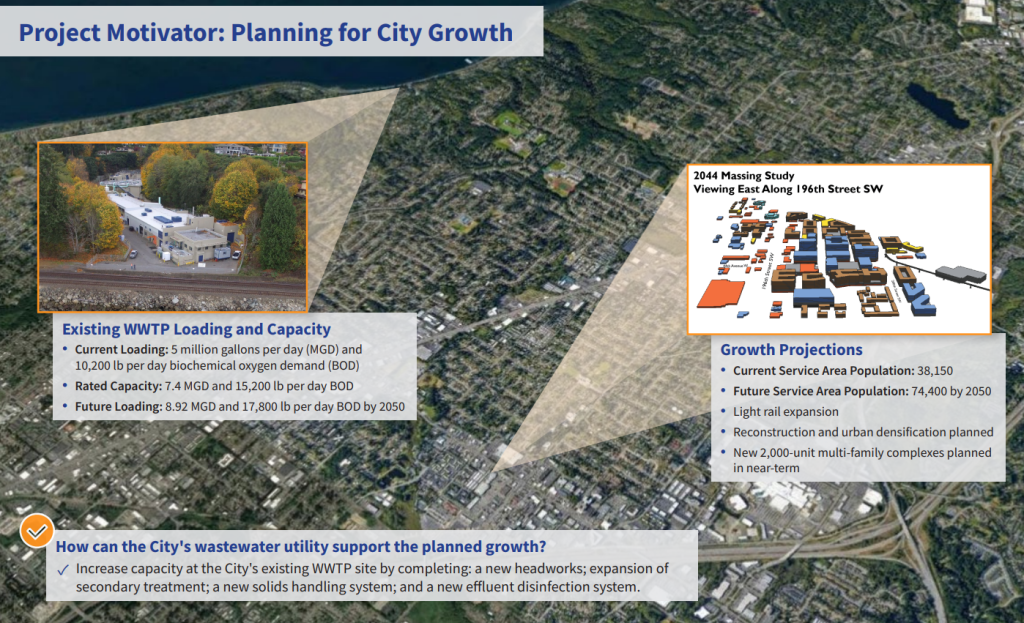LYNNWOOD, Wash., February 23, 2022 – Lynnwood City Council discussed the need for a Wastewater Treatment reconstruction, as well as the increase in crime, and utility charges at its Work Session February 16.
Wastewater Treatment Reconstruction Project
Deputy Director Lester Rubstello and Public Works Director Bill Franz led council through major points on the much-needed reconstruction of Lynnwood/Edmond’s Wastewater Treatment Plant (WWTP), which received its original primary treatment 60 years ago, expanded primary treatment 40 years ago, and expansion to provide secondary treatment 30 years ago.
Rubstello pointed out that most of the equipment at the Wastewater Treatment Plant is 30 to 40 years old, is difficult to maintain, and spare parts are often unavailable for the aging equipment.

The maximum daily flow exceeds capacity for most processes, peak wet weather storm flows necessitate bypass of partially treatment wastewater, and the current plant configurations is complicated and limits site utilization for expanded capacity.
There are also permit issues involved with air quality violations related to sludge incineration.
The Department of Ecology issued the Puget Sound Nutrient General Permit (PSNGP), which went into effect January 2022, based on water quality standards for dissolved oxygen not being met in many locations in Puget Sound.
The PSNGP applies to 58 domestic WWTPs discharging to the Puget Sound and Salish sea and aims to address decreasing oxygen levels caused by nutrient discharge.
With the projected growth of Lynnwood, with the light rail expansion, the future service area population is predicted to need to serve 74,400 by 2050. Currently the service area population the site is capable of serving is 38,150. This also takes into consideration new 2,000-unit multi-family complexes that are currently being planned to be built in the area near-term.
The treatment plants current loading capacity is 5 million gallons per day (MGD) and 10,200 pounds per day of biochemical oxygen demand (BOD). By the year 2050 the treatment plant is predicted to need a capacity to load 8.92 MGD and 17,800 per day of BOD.

Rubstello and Franz recommended to council, to resolve these issues, the treatment plant will require increased capacity at the City’s existing WWTP site involving a new headworks, expansion of secondary treatment, a new solids handling system, and a new effluent disinfection system. They recommend these updates in three phases:
- Phase 1 (2025): Grading, utilities, and preparation of WWTP site with an estimated cost of $19 million.
- Phase 2 (2026-2028): New headworks, additional basins, and effluent disinfection with an estimated cost of $119 million.
- Phase 3 (2029-2031): New solids handling facility with an estimated cost of $60 million.
City council agreed to take a tour of the treatment this Saturday, February 26, to see the facility’s need for upgrades in person.
Addressing crime
Chief Nelson walked the counsel through an increase in crime Lynnwood is experiencing, centering on graffiti.
Nelson admitted through the pandemic police response to graffiti has not been up to standard, which he attributes to staffing challenges. Although there is currently only one vacant, funded, police position there are 13 vacancies “functionally” due to leave, training, awaiting academy, and so on.
In the past, the Lynnwood PD had a graffiti patrol of volunteers but that subsided during the pandemic. Nelson wishes to get back to utilizing volunteers for this purpose now that the city is beginning to open up.
Lynn Sordel, Director of Public Parks and Recreation, thanked Chief Nelson’s acknowledgment of this ongoing issue providing his observation of an increase in vandalism and graffiti since last November, when the state began entering darker months earlier, resulting in the closure of many park restrooms.
“[Graffiti] makes people feel unsafe even if they are more safe than they know,” Councilwoman Sessions said.
Chief Nelson is working with his force on how to address the increase in graffiti including a “spring cleanup” program, although this is just in its idea phase.
George Hurst asked Chief Nelson if crime, in general, is spiking in Lynnwood.
Nelson replied that Lynnwood is such a commercial city that when COVID hit, cases actually declined but as the city is beginning to open up, crime is increasing with it.
“Businesses were closed so there’s no crime happening in them and when there’s less people in the city there’s less crimes of opportunity,” Nelson said. “As the city begins to open up we are seeing increases but not to the same rates as our neighbors.”
Utility Rate Study
In addition to crime and the Wastewater treatment plant, Public Works Director Bill Franz presented council with a recent utility rates study, joined by Senior Project Manager Sergey Tarasov and Project Manager Brooke Tacia.
The last comprehensive study on utility rates was in 2019 which resulted in a six-year rate plan for each utility. The study is revisited every three years to evaluate progress.
The rate plan established in the study showed the following rate plan for each utility for the next six years.
[Insert attached photo here]
Author: Kienan Briscoe









